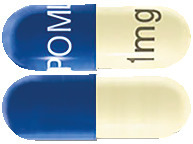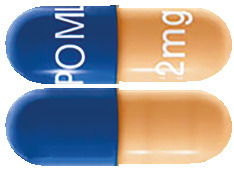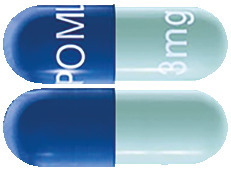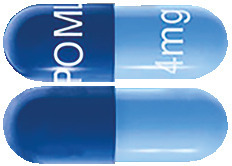WHAT IS IN THIS LEAFLET
This leaflet answers some common questions about Pomalyst.
It does not contain all the available information.
It does not take the place of talking to your doctor or pharmacist.
All medicines have risks and benefits. Your doctor has weighed the risks of you taking Pomalyst against the benefits this medicine is expected to have for you.
If you have any concerns about taking this medicine, ask your doctor or pharmacist.
Keep this leaflet with the medicine. You may need to read it again.
WHAT POMALYST IS USED FOR
Pomalyst contains an active substance called pomalidomide.
Pomalyst belongs to a group of medicines called immunomodulating agents.
Pomalyst is used in combination with another medicine called 'dexamethasone' (steroid medicine) to treat adult patients diagnosed with Multiple Myeloma (MM) (a cancer of the bone marrow). It is prescribed for patients whose disease has progressed after two prior therapies.
Pomalyst is also used in combination with dexamethasone and another medicine called 'bortezomib' to treat adult MM patients whose disease has progressed after one therapy.
Ask your doctor if you have any questions about how Pomalyst works or why this medicine has been prescribed for you. Your doctor may have prescribed it for another reason.
This medicine is not addictive.
Pomalyst will only be prescribed to you by a doctor who has experience in medicines to treat cancers of the blood.
BEFORE YOU TAKE POMALYST
When you must not take it
Do not take Pomalyst if you have an allergy to pomalidomide or any of the ingredients listed at the end of this leaflet.
Some of the symptoms of an allergic reaction may include:
- shortness of breath
- wheezing or difficulty breathing
- swelling of the face, lips, tongue or other parts of the body
- rash, itching or hives on the skin.
If you think you may be allergic to Pomalyst, ask your doctor for advice.
Do not take this medicine if you are pregnant, or think that you are pregnant. Pomalyst may cause birth defects (deformed babies), and may affect your developing baby if you take it during pregnancy.
Do not take this medicine if you are able to become pregnant, unless you are willing to follow the required pregnancy prevention measures (outlined in Celgene's i-access® program - see section 'Before you start to take it').
If you are not sure whether you should start taking this medicine, talk to your doctor.
Before you start to take it
Follow your doctor's instructions carefully.
You will have been given specific instructions by your doctor particularly on the potential effects of pomalidomide on unborn babies.
If you have not fully understood these instructions, ask your doctor again before taking Pomalyst.
Your doctor will have enrolled you in the i-access program to ensure that pomalidomide is used safely.
The i-access® program
Pomalyst (pomalidomide) is structurally related to 'thalidomide', which is known to cause severe life-threatening human birth defects (deformed babies) and death to an unborn baby if taken during pregnancy. If Pomalyst is taken during pregnancy, it may cause birth defects or death to an unborn baby.
To avoid exposure to unborn babies, Pomalyst has restricted availability under a Pregnancy Prevention Program (i-access). This program is designed to ensure that this medicine is always prescribed and taken in the recommended way. Importantly, only patients who are formally enrolled in this program and agree to fully comply with all the requirements of this program can receive Pomalyst.
Some of the requirements of the i-access® program are outlined in the following sections. Your doctor will discuss all the details with you.
- For women taking Pomalyst
Before starting this treatment, your doctor will discuss your potential to become pregnant, even if you think this is unlikely e.g. if your periods have stopped.
Follow instructions below if you are able to become pregnant:
- Your doctor will discuss the potential risk to unborn babies if Pomalyst is taken during pregnancy.
- You will be required to have pregnancy tests before treatment, every 4 weeks during treatment, and 4 weeks after stopping treatment.
- Take Pomalyst medicine as soon as you get it from the pharmacy following a negative pregnancy test.
- Use reliable means of contraception for at least 4 weeks before starting Pomalyst treatment, during treatment and treatment interruption, and for at least 4 weeks after Pomalyst treatment has stopped.
Your doctor will tell you what method of contraception to use.
You must stop taking Pomalyst and inform your doctor straight away if:
- You miss or think you have missed a period, or you have unusual menstrual bleeding, or suspect you are pregnant.
- You have heterosexual intercourse without using reliable means of contraception.
Discuss with your doctor if you should breast-feed whilst taking this medicine.
It is not known if Pomalyst is excreted in human milk. Therefore, you should discuss with your doctor whether to discontinue breast-feeding while you are receiving this medicine.
- For men taking Pomalyst
Before starting this treatment, discuss with your doctor if your partner is able to become pregnant.
If your partner is able to become pregnant, use barrier methods of contraception (e.g. condoms) even if you are vasectomised, during Pomalyst treatment, during treatment interruption, and for at least 1 week after treatment has stopped.
Tell your doctor immediately if your partner becomes pregnant whilst you are taking this medicine.
Do not donate semen during treatment or during treatment interruption, or for 1 week after stopping treatment.
- For all patients taking Pomalyst
Discuss with your doctor if you have or have had any of the following medical conditions:
- Blood clots
- Frequent bleeding or bruising
- Frequent infections
- Peripheral neuropathy (numbness, tingling, weakness, abnormal co-ordination or pain in your hands and feet)
- Abnormal kidney function
- Allergic reactions to thalidomide or lenalidomide
- Hepatitis B virus infection.
If you have not told your doctor about any of the above, tell him/her before you start taking Pomalyst.
Do not donate blood during Pomalyst treatment or during treatment interruption, and for at least 1 week after stopping treatment.
In Australia, patients with myeloma are permanently excluded from donating blood.
Tell your doctor if you have allergies to any other medicines, foods, preservatives or dyes.
Tell your doctor if you smoke. Smoking may affect Pomalyst or may affect how it works.
Your doctor will ask you to have regular blood tests during treatment with Pomalyst. Your doctor may adjust your dose of Pomalyst or stop your treatment based on the results of your blood tests and on your general condition.
Do not give this medicine to a child or adolescent under the age of 18 years. Safety and effectiveness in children younger than 18 years have not been established.
It is important to note that a small number of patients with multiple myeloma may develop additional types of cancer (regardless of their type of therapy). At this stage, it cannot be excluded that this risk may be slightly increased with Pomalyst treatment. Therefore, your doctor will carefully evaluate the benefit and risk when you are prescribed this medicine. Superficial skin cancers have been observed in a small number of multiple myeloma patients treated with Pomalyst.
Taking other medicines
Tell your doctor or pharmacist if you are taking any other medicines or have recently taken any other medicines, including any medicines that you buy without a prescription from a pharmacy, supermarket or health food shop.
Tell your doctor if you are taking medications used to treat depression or obsessive compulsive disorder (OCD). Some of these medicines and Pomalyst may interfere with each other.
HOW TO TAKE POMALYST
Follow all directions given to you by your doctor carefully. They may differ from the information contained in this leaflet.
How much to take
Your doctor will tell you how much Pomalyst to take and for how long you will need to take it. Your doctor will monitor your progress and may adjust your dose.
Your doctor may adjust your dose of Pomalyst or stop your treatment based on the results of your blood tests and on your general condition.
How to take it
Swallow the capsules whole with a full glass of water, once a day as directed by your doctor.
Pomalyst can be taken with or without food.
Do not open, break or chew the capsules.
If powder from the capsules contacts the skin, wash the skin immediately and thoroughly with soap and water. If pomalidomide contacts the mucous membranes e.g. the eyes, flush thoroughly with water.
When to take it
Take your medicine at about the same time each day. If you are on dialysis, on dialysis days take your medicine after dialysis.
How long to take it
Your doctor will tell you how long to continue taking Pomalyst.
If you forget to take it
If it is less than 12 hours before your next dose, skip the dose you missed and take your next dose when you are meant to.
Otherwise, take it as soon as you remember, and then go back to taking your medicine as you would normally.
Do not take a double dose to make up for the dose that you missed.
If you are not sure what to do, ask your doctor or pharmacist.
If you have trouble remembering when to take your medicine, ask your pharmacist for some hints.
If you take too much (overdose)
In Australia, immediately telephone your doctor or Poisons Information Centre (telephone 13 11 26) for advice, or go to Accident and Emergency at your nearest hospital, if you think that you or anyone else may have taken too much Pomalyst.
In New Zealand, immediately telephone your doctor or the National Poisons Centre (telephone 0800 POISON or 0800 64 766) for advice, or go to Accident and Emergency at your nearest hospital, if you think that you or anyone else may have taken too much Pomalyst.
Do this even if there are no signs of discomfort or poisoning. Keep the telephone numbers for these places handy.
WHILE YOU ARE TAKING POMALYST
Things you must do
Female patients:
- Tell your doctor immediately if you suspect that you may be pregnant. You should also immediately stop taking Pomalyst in this case.
All patients:
- Tell any other doctors, dentists, and pharmacists who are treating you that you are taking Pomalyst.
- If you are about to be started on any new medicine, remind your doctor, dentist or pharmacist that you are taking Pomalyst.
- Keep all of your doctor's appointments so that your progress can be checked.
Your doctor will do some tests (blood tests) regularly to make sure the medicine is working and to prevent unwanted side effects.
Things you must not do
Female patients:
- Do not become pregnant whilst taking Pomalyst.
Male patients:
- Do not donate semen during treatment or treatment interruption, or for at least 1 week after stopping treatment.
All patients:
- Do not have sexual intercourse without using effective means of contraception described to you by your doctor.
- Do not donate blood during treatment or treatment interruption, or for at least 1 week after stopping treatment.
In Australia, patients with myeloma are permanently excluded from donating blood. - Do not stop taking Pomalyst (unless you suspect that you are pregnant) or change the dose without first checking with your doctor.
- Do not let yourself run out of medicine over the weekend or on holidays.
- Do not give this medicine to anyone else, even if they have the same condition as you.
- Do not take this medicine to treat any other complaints unless your doctor or pharmacist tells you to.
- Do not take this medicine after the expiry date printed on the pack or if the packaging is torn or shows signs of tampering.
In that case, return it to your pharmacist.
Things to be careful of
Be careful driving or operating machinery until you know how Pomalyst affects you. This medicine may cause dizziness or confusion in some people. If you have any of these symptoms, do not drive, operate machinery or do anything else that could be dangerous.
SIDE EFFECTS
Tell your doctor or pharmacist as soon as possible if you do not feel well while you are taking Pomalyst.
Like all medicines, Pomalyst can have side effects, although not everybody gets them and some are uncommon. Sometimes they are serious, most of the time they are not. You may need medical attention if you get some of the side effects.
Do not be alarmed by the following list of side effects. You may not experience any of them.
Tell your doctor if you notice any of the following and they worry you:
- Constipation, diarrhoea, feeling sick (nausea), vomiting, decrease in appetite, pain in the lower abdomen or pelvic area, gastrointestinal bleeding.
- Itchiness or rash.
- Dizziness or spinning sensation, shaking or tremors, feeling faint or confused.
- Bone pain or muscle spasms.
The above list mainly includes the more common side effects of your medicine.
Tell your doctor immediately if you notice the following:
- Heart palpitations or fast heartbeat, chest pains, dizziness or fainting, shortness of breath, weakness or reduced ability to exercise.
These could be symptoms of atrial fibrillation (irregular heartbeat). - Bleeding or bruising more easily than normal,
Pomalyst can reduce the number of platelets, which are responsible for making the blood clot properly. Your doctor will monitor your blood cell numbers during treatment with Pomalyst. - Tiredness, headaches, shortness of breath, dizziness and looking pale
Pomalyst can reduce the number of red blood cells that carry oxygen around the body. - Chest pain and dry cough
This may be due to a chest infection e.g. pneumonia. - Wheezing, shortness of breath or a chronic cough
These may be symptoms caused by inflammation of the connective tissues in the lungs. - Numbness, tingling, abnormal co-ordination or pain in your hands and feet
This may be due to nerve damage. - Blurred, loss of or double vision, difficulty speaking, weakness in an arm or a leg, a change in the way you walk or problems with your balance, persistent numbness, decreased sensation or loss of sensation, memory loss or confusion.
These may be symptoms of a serious and potentially fatal brain condition known as progressive multifocal leukoencephalopathy (PML).
The above list includes serious side effects that may require medical attention.
If any of the following happens, stop taking Pomalyst and see a doctor immediately or go to Accident and Emergency at your nearest hospital:
- Shortness of breath, wheezing or difficulty breathing; swelling of the face, lips, mouth, tongue or throat which may cause difficulty in swallowing or breathing; swelling of other parts of the body; rash, itching or hives on the skin; flaking or peeling of the skin.
These could be symptoms of an allergic reaction. - Severe blisters and bleeding in the lips, eyes, mouth, nose and genitals; painful red area on the skin that spreads quickly; peeling of the skin. You may have a high temperature, chills and muscle ache at the same time.
These could be due to rare but severe skin reactions such as Stevens-Johnson Syndrome, Toxic Epidermal Necrolysis and Drug Reaction with Eosinophilia and Systemic Symptoms. - Sudden pain in your chest or difficulty in breathing
This may be due to blood clots in the artery leading to your lungs. These can happen during treatment, or after treatment has stopped. - Chest pain, severe weakness, rapid or irregular heartbeat, and/or sudden, severe shortness of breath.
This could be due to heart failure, a condition where the heart muscle cannot pump blood strongly enough to supply blood throughout the body. - Pain or swelling in your legs, especially in your lower leg or calves
This may be due to blood clots in the veins of your leg. These can happen during treatment, or after treatment has stopped. - Fever, severe chills, rapid breathing, shortness of breath, rapid pulse, confusion, nausea, vomiting, diarrhoea, pain or burning when you urinate, cough, phlegm, sore mouth or throat, or mouth ulcers.
These could be symptoms of sepsis (blood infection) or other serious infections such as pneumonia. - Passing little or no urine, drowsiness, nausea, vomiting or breathlessness.
These could be symptoms of kidney disease. - Yellowing of the skin and/or eyes.
These are symptoms of jaundice which can result from liver failure or a liver disease called hepatitis.
The above list includes very serious side effects. You may need urgent medical attention or hospitalisation.
Tell your doctor or pharmacist immediately if any of the side effects gets worse, or if you notice any other side effects not listed in this leaflet.
AFTER TAKING POMALYST
Storage
Keep your capsules in a cool dry place where the temperature stays below 25°C.
Keep your capsules in the original pack until it is time to use them.
Keep this medicine where children cannot reach it. A locked cupboard at least one-and-a-half metres above the ground is a good place to store medicines.
Disposal
If your doctor tells you to stop taking this medicine or the expiry date has passed, take any unused Pomalyst capsules to your pharmacist.
Medicines should not be disposed of via wastewater or household waste. These measures will help to protect the environment.
PRODUCT DESCRIPTION
What Pomalyst looks like
The capsules are provided in packs. There are two (2) pack sizes available. A pack will contain either three blisters, each with seven capsules, giving a total of twenty-one (21) capsules per pack or two blisters, each with seven capsules, giving a total of fourteen (14) capsules per pack.
Pomalyst 1 mg capsules are yellow opaque body/dark blue opaque cap capsules with "POML 1 mg" written on them.
Pomalyst 2 mg capsules are orange opaque body/dark blue opaque cap capsules with "POML 2 mg" written on them.
Pomalyst 3 mg capsules are green opaque body/dark blue opaque cap capsules with "POML 3 mg" written on them.
Pomalyst 4 mg capsules are blue opaque body/dark blue opaque cap capsules with "POML 4 mg" written on them.
Ingredients
Pomalyst capsules contain an active ingredient called pomalidomide.
The other ingredients are:
- mannitol,
- pregelatinised starch, and
- sodium stearyl fumarate.
The capsule shells contain:
- 1 mg capsules: gelatine, titanium dioxide, colourants (indigo carmine and yellow iron oxide), white ink (Shellac, titanium dioxide, simethicone, propylene glycol and ammonium hydroxide) and black ink (Shellac, iron oxide black, propylene glycol and strong ammonia solution)
- 2 mg capsules: gelatine, titanium dioxide, colourants (indigo carmine, yellow iron oxide and erythrosine) and white ink (Shellac, titanium dioxide, simethicone, propylene glycol and strong ammonia solution)
- 3 mg capsules: gelatine, titanium dioxide, colourants (Indigo carmine and yellow iron oxide) and white ink (Shellac, titanium dioxide, simethicone, propylene glycol and strong ammonia solution)
- 4 mg capsules: gelatine, titanium dioxide, colourants (Indigo carmine and brilliant blue FCF) and white ink (Shellac, titanium dioxide, simethicone, propylene glycol and strong ammonia solution)
This medicine does not contain lactose.
Supplier
Pomalyst is supplied in Australia by:
Celgene Pty Limited
Level 2, 4 Nexus Court
Mulgrave, VIC 3170
Telephone: 1800 CELGENE
(1800 235 4363)
® = Registered Trademark
This leaflet was updated in May 2022.
Australian Registration Numbers:
Pomalyst (pomalidomide) 1 mg capsules - AUST R 212657
Pomalyst (pomalidomide) 2 mg capsules - AUST R 212654
Pomalyst (pomalidomide) 3 mg capsules - AUST R 212656
Pomalyst (pomalidomide) 4 mg capsules - AUST R 212655
(Celgene V4.0)
Published by MIMS June 2022











 The median duration of treatment was 38.3 weeks in the Pom + Btz + LD-dex arm and 21.4 weeks in the Btz and LD-dex arm.
The median duration of treatment was 38.3 weeks in the Pom + Btz + LD-dex arm and 21.4 weeks in the Btz and LD-dex arm.



 Patients with serum bilirubin > 34.2 micromol/L and transaminases > 3 x ULN were excluded from the efficacy studies.
Patients with serum bilirubin > 34.2 micromol/L and transaminases > 3 x ULN were excluded from the efficacy studies.
